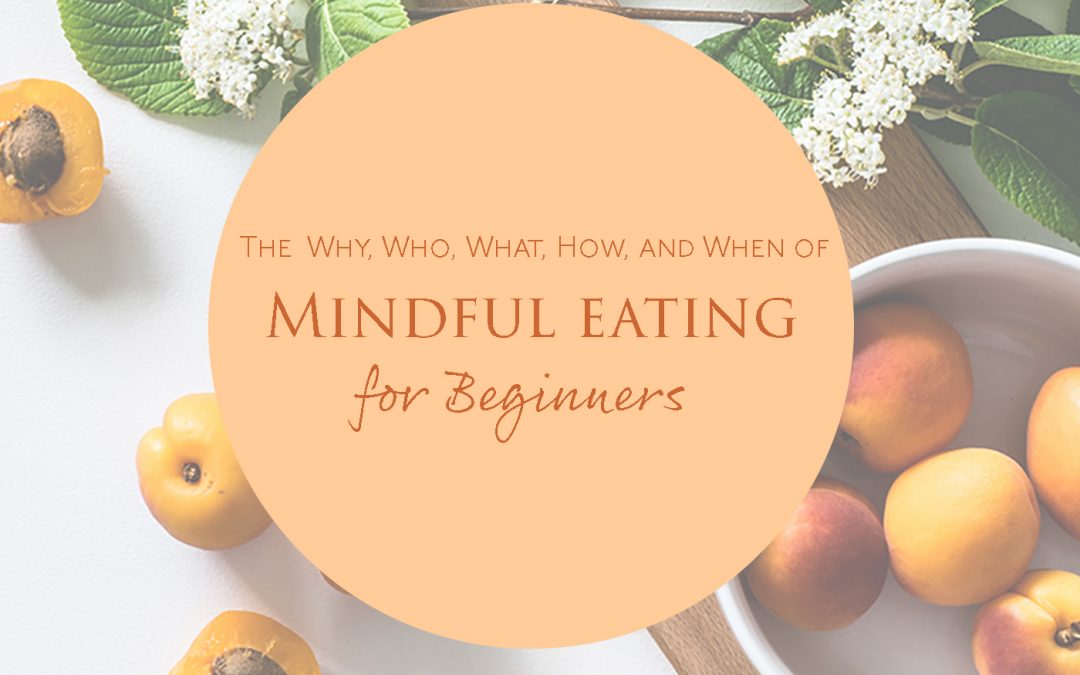This article will tell you the Who, What, Why, How, and When of Mindful Eating:
-
Why you want to try it
-
Who can benefit from mindful eating
-
What it is
-
How to eat mindfully
-
And the best times to start a mindful eating practice in your everyday life.
What do you get when you combine a popularity spike in anti-diet culture and practices like meditation?
An explosive interest in mindful eating, which has spread through the wellness world faster than the takeover of wide-legged jeans in fashion.
And this is a great thing.
Because mindful eating has the potential to change the entire paradigm of the diet and weight-loss industry, which, let’s be honest, is in major need of a makeover.
Better than avoiding carbs or counting calories, mindful eating is one of the most empowering and enriching things you can do for yourself and your body.
Every meal turns into an opportunity for healing, connection, and deep satisfaction when you practice mindful eating.
Mindful eating can help to reduce stress and anxiety, increase joy, improve your connection with your body, and help you heal your relationship with food so you feel less inclined to binge-eat, overeat, stuff yourself with sugar, or use food to abuse yourself in any way. 1
Mindful eating also has physical benefits.
Because digestion begins in your mind.
Your body literally has a physiological reaction that superpowers your digestion when you think about yummy foods.
Smell something delicious like that umami-drenched bowl of pho that you’ve been craving and that superpower increases even more.
So by eating mindfully you can reduce gas and bloating, stomach pain, acid-reflux, and increase the nutrients your body is able to absorb.
Who benefits from mindful eating?
Mindful eating is a great practice for anyone who has a tongue and cheek.
And it can be especially powerful for people who struggle with diets, binging, overeating, and body-image issues.
(Scary fact: 97% of women are dealing with at least one of these issues right now). 2
Mindful eating can also help people who want to understand how different foods can help or harm their unique body.
Because when you eat mindfully, it gives you the opportunity to tune into how your body responds to the food you’re eating.
Does it make you feel light or heavy?
Do you feel hungry after 20 minutes or are you satiated for hours?
Does your stomach tighten or relax when you eat this?
Does your mind feel cloudy or clear?
All of these observations give you more information about which foods are actually healthy or unhealthy for you than any diet prescribed by someone outside of your body ever can.
So what is mindful eating, and mindfulness in general?
The essence of mindfulness is the practice of being focused on the present moment without judgment.
And mindful eating is the practice of using mealtimes as an opportunity to be more present without judgment.
The term “mindfulness” was coined by Jon Kabat-Zinn, the original developer and leader of the Mindfulness-Based Stress Reduction program at the University of Massachusetts Medical School.
But some version of mindfulness has been practiced for thousands of years around the globe in various spiritual traditions, from Buddhism and Hinduism to Judaism, Christianity, and Islam. 2
The word mindfulness is actually a bit misleading.
Mindlessness might be more accurate, though that could imply a lack of presence and could be easily misunderstood as well.
Whatever you want to call it, mindfulness is about experiencing life without your mind interpreting everything that’s happening.
It’s the act of perceiving without labeling.
And it is in this perception that you’re able to come in full contact with the life you’re living, right here, right now, as you’re living it.
This means that you are able to appreciate the magic that is right in front of you, because you’re not busy imagining the way things were or the way things could be.
And you’re able to live with more integrity, because you can honestly look at what’s in front of you without comparing it or clouding it over with what’s in your head.
In the case of mindful eating, this means that you’re finally able to enjoy your food instead of worrying about what it’ll do to your thighs, or just scarfing it down without even really registering how it tastes.
Most of us eat (and live) in a state of constant distraction.
Maybe you’re focused on the things other people around you are saying.
I’ll bet $10 bucks that you spend a good portion of your meals staring at a screen.
And if I could count the times I see people eating while driving I’d be a whole lot richer than that.
Mindful eating helps you slow down and smell the Roma tomatoes.
It’s the best way to take all of the benefits of meditation and carry them into your everyday life.
And you don’t have to sit quietly for any amount of time to do it.
All you have to do is be here, witnessing yourself eating food, right now.
How do you eat mindfully?
The best place to start is by coming into your senses, as Jon Kabat-Zinn likes to say.
Start by sitting down.
And come into contact with your food without touching it.
By this I mean, notice how your food looks and smells.
Take some time to appreciate the colors and light hitting your plate or bowl (or napkin, no judgment here).
Close your eyes and feel the effect the aromas have on your body.
Then dig in, slowly!
If you’re eating with your hands, feel the texture of the food before you bite.
If you’re eating with utensils, take a moment to feel the weight of that fork or spoon or chopsticks in your fingers.
You might feel inspired to marvel at how cool it is that you can literally feel your food through them without ever touching it.
Take your first bite just as slowly, noticing the feeling of your teeth and lips and tongue connecting with your food.
Close your eyes as you experience the food in your mouth, observing where the flavors hit in your mouth as they arise and change.
Chew thoroughly, and pause before you swallow.
Feel the food reaching your stomach before you take your next bite.
Pause and breathe.
Repeat.
When to Eat Mindfully.
You can intentionally choose a meal to eat mindfully once a day (breakfast is best for most people, but whatever works for you is great.)
You could eat a full meal mindfully once a week.
Or just create a mindful eating ritual around the beginning of each meal and see where life takes you for the rest.
You might think it’s impossible to eat mindfully with other people (especially kids who are demanding more ketchup just as you’re trying to focus in on the feel of your hamburger bun).
But mindful eating doesn’t have to be the stuffy, quiet, or boring experience you might imagine it to be.
In fact, it’s exactly the opposite.
Mindfulness is about coming into full contact with whatever experience is in front of you.
And while a meditative meal might be lovely every once in a while, most of us live in a more lively environment, and that’s really great, too.
So if you’re eating with other people, experiment to see how present you can be with your food and the other people at the same time.
As is the case with all meditative practices, at first you will easily be distracted.
Your thoughts will come in and the next thing you know you’re scooping the last bit of egg-yolk up with your toast when you realize you pretty much missed the rest of the meal.
It’s even more challenging when there is the noise of other people expressing their own thoughts around you, asking for a response.
That’s ok.
It’s all part of it.
With practice, you will notice that it gets easier to be present regardless of what’s going on, within or around you.
And over time, the benefits will ripple out not only in your own life, but to everyone you come in contact with.
Prepare to be amazed.
References:
1. https://www.sciencedirect.com/science/article/pii/S2007078017300123





